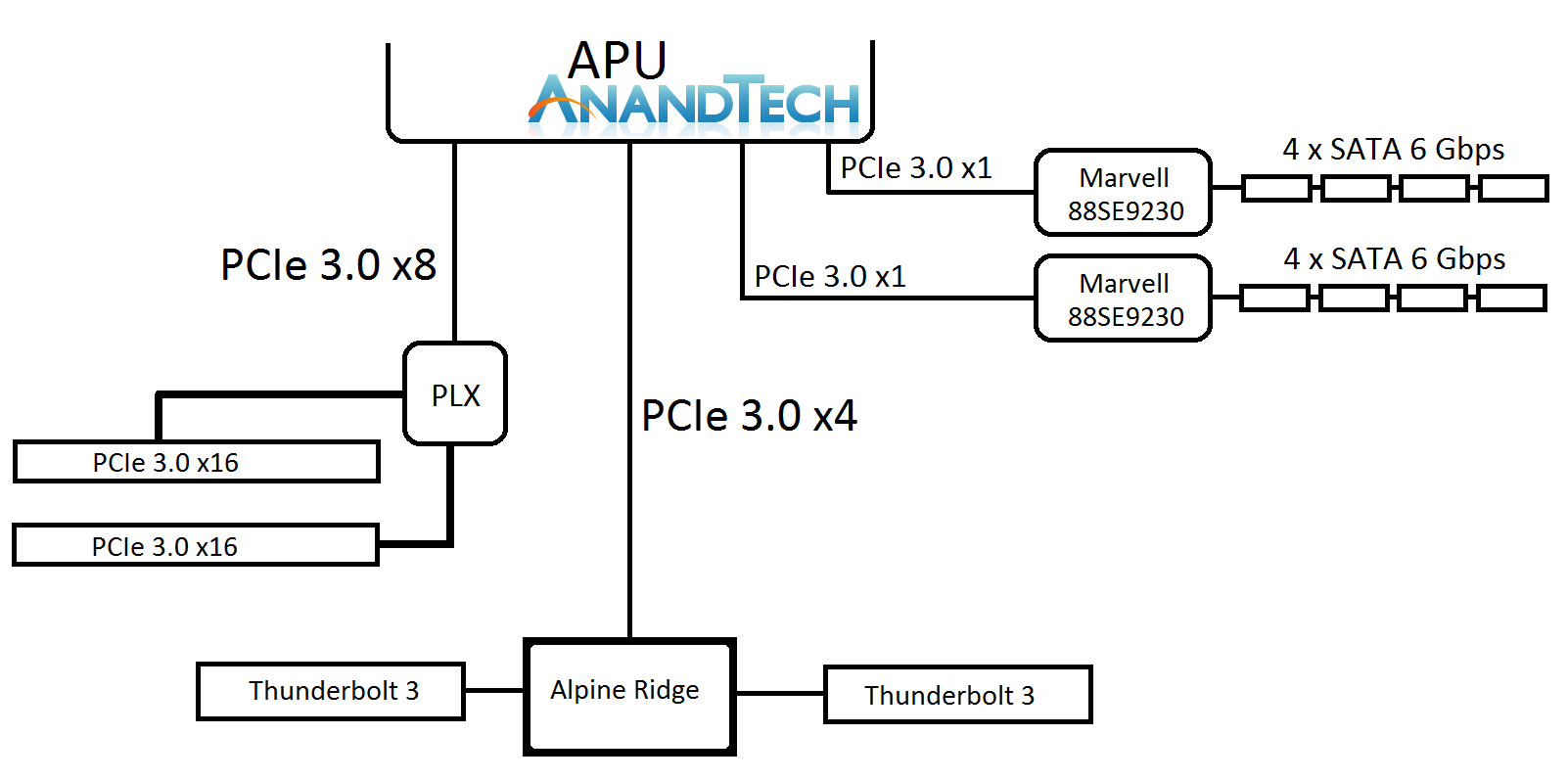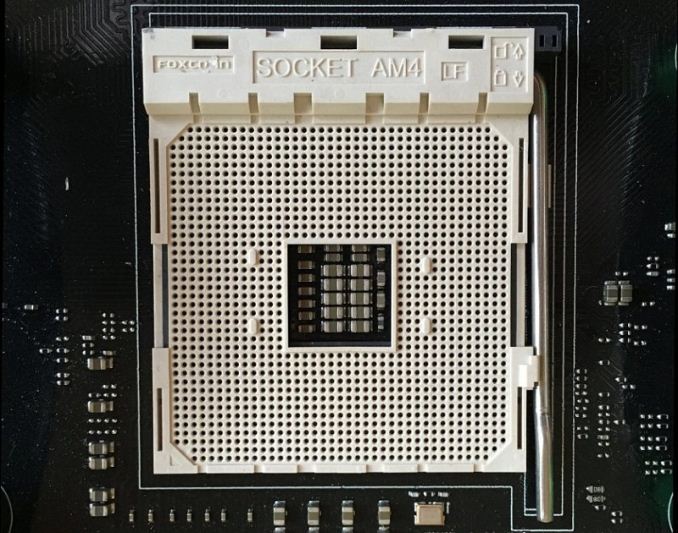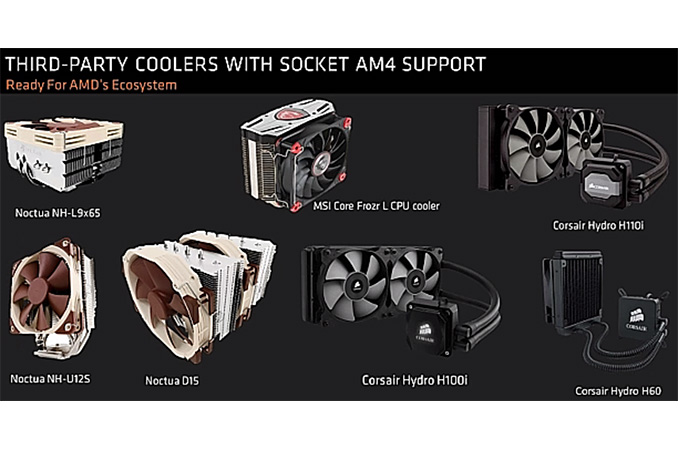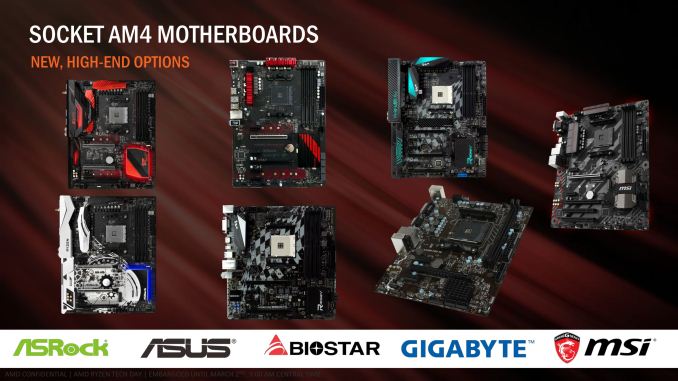The AMD Zen and Ryzen 7 Review: A Deep Dive on 1800X, 1700X and 1700
by Ian Cutress on March 2, 2017 9:00 AM ESTChipsets and Motherboards: 300-series and AM4
Users keeping tabs on the developments of CPUs will have seen the shift over the last ten years to moving the traditional ‘northbridge’ onto the main CPU die. The northbridge was typically the connectivity hub, allowing the CPU to communicate to the PCIe, DRAM and the Chipset (or Southbridge), and moving this onto the CPU silicon gave better latency, better power characteristics, and reduced the complexity of the motherboard, all for a little extra die area. Typically when we say ‘CPU’ in the context of a modern PC build, this is the image we have, with the CPU containing cores and possibly graphics (which AMD calls an APU).
Typically the CPU/APU has limited connectivity: video outputs (if an integrated GPU is present), a PCIe root complex for the main PCIe lanes, and an additional connectivity pathway to the chipset to enable additional input/output functionality. The chipset uses a one-to-many philosophy, whereby the total bandwidth between the CPU and Chipset may be lower than the total bandwidth of all the functionality coming out of the chipset. Using FIFO buffers, this is typically managed as required. The best analogy for this is that a motorway is not 50 million lanes wide, because not all cars use it at the same time. You only need a few lanes to cater for all but the busiest circumstances.
If the CPU also has the chipset/southbridge built in, either in the silicon or as a multi-chip package, we typically call this an ‘SoC’, or system on chip, as the one unit has all the connectivity needed to fully enable its use. Add on some slots, some power delivery and firmware, then away you go.
Platform = SoC + Chipset (Optional)
The AM4 platform will cater for both Ryzen CPUs (Summit Ridge, SR) and the second generation of Excavator APUs (Bristol Ridge, BR). As a result, the capabilities of the two have share some commonality in order to be interoperable with the same motherboard products. As a result, there is only a few minor differences:
Here is Bristol Ridge, with eight PCIe 3.0 lanes for add-in cards, two SATA 6 Gbps, four USB 3.0 ports, two PCIe x1 lanes, and a PCIe x4 lane for the chipset. The chipset is optional, as those four lanes could be put to use elsewhere (or bifurcated into x1/x1/x2 as required) when extra IO is not needed.
What differs with Ryzen and Summit Ridge is numbers: sixteen lanes for add-in cards and four SATA 6 Gbps ports plus an x2 NVMe (or two SATA plus an x4 NVMe). What AMD is doing with AM4 is a half-way house between a SoC and having a fully external chipset. Some of the connectivity, such as SATA ports, PCIe storage, or PCIe lanes beyond the standard GPU lanes, is built into the processor. These fall under the features of the processor, and for the current launch is a fixed set of features. The CPU also has additional connectivity to an optional chipset which can provide more features, however the use of the chipset is optional.
PCIe is Fun with Switches: PLX, Thunderbolt, 10GigE, the Kitchen Sink
Another thing about the x16 link or x8/x8 links, rather than say a total of 28/40 lanes, is that it can be combined with an external PCIe switch. In my discussions with AMD, they suggested a switch that bifurcates a x8 to dual x4 interfaces, which could leverage fast PCIe storage while maintaining the onboard graphics for any GPU duties. There’s the other side, in using an x16 or x8 to x32 PCIe switch and affording two large x16 links.
Here’s a crazy mockup I thought of, using a $100 PCIe switch. I doubt this would come to market.

Ian plays a crazy game of PCIe Lego
The joy of PCIe and switches is that it becomes a mix and match game - there’s also the PCIe 3.0 x4 to the chipset. This can be used for non-chipset duties, such as anything that takes PCIe 3.0 x4 like a fast SSD, or potentially Thunderbolt 3. We discussed TB3 support, via Intel’s Alpine Ridge controller, and we were told that the AM4 platform is currently being validated for systems supporting AMD XConnect, which will require Thunderbolt support. AMD did state that they are not willing to speculate on TB3 use, and from my perspective this is because the external GPU feature is what AMD is counting on as being the primary draw for TB3 enabled systems (particularly for OEMs). I suspect the traditional motherboard manufacturers will offer wilder designs, and ASRock likes to throw some spaghetti at the wall, to see what sticks.
The AM4 Socket
One of the common perceptions of AMD is that they like to keep a socket for many, many generations. Both AM3/3+ and FM2/2+ have existed for at least three generations of CPUs a piece, and the main thinking here is that backwards compatibility was important. Because Ryzen requires DDR4 memory, enables PCIe, and perhaps some other magic, more pins and a new socket is needed, breaking that trend. The new CPU uses 1331 pins, up from the 939-941 we’ve had before, but essentially in the same dimensions, meaning that the pins are smaller and now easier to break / accidentally smear thermal grease into and not be able to get it out.
The socket then changes to accommodate the pins, however AMD is still using a zero insertion force (ZIF) method for contact. Which means every so often, if I have a good seal between the CPU and the heatsink, removing the heatsink also removes the CPU – not a critical issue, but not the preferred state of things.
The socket hole mounting does change however, from AM3 to AM4. On AM3 the dimensions were, center hole to center hole, 96mm x 48mm. This led to a very cumbersome rectangular design for sure. AM4 makes the design more square, down to 90mm x 54mm, but is still very square. With the new mounting holes, users will need brackets for existing CPU coolers or buy new coolers with the new brackets. More on that in a second.
It is worth noting that AMD has still kept the same mounting mechanism from AM3 for coolers that use a spring loaded mount on AMD’s plastic clips. So users with a spring loaded mount cooler, will still be able to use it as the plastic clip on the new boards is in the right place. Some motherboard manufacturers are also taking the initiative, and implementing both sets of AM3 and AM4 hole mounts such that the older coolers will be able to be used. However, using an older cooler might result in a few issues depending on the screw height, as reviewers have already been complaining about bad contact. In our review today, we used a Noctua DH-U12S SE-AM4 cooler that implements rails and then a secondary screw system, and it has none of the issues we just described. Ultimately all motherboards will end up just with AM4 holes, but it should facilitate smaller form factor motherboards where AM3 was perhaps too rectangular.
| Coolers Supporting AMD Ryzen Processors in AM4 Form-Factor | ||||||
| Manufacturer | Already Compatible |
Requires New Mounting Kit |
Upcoming | |||
| ARCTIC | Alpine 64 Plus Alpine 64 Pro Alpine 64 GT Freezer 7 Pro Freezer 13 Freezer 13 Limited Freezer 13 CO Freezer Extreme |
Liquid Freezer 120/240/360 (kit to be available in April) | Freezer 12 Freezer 33 |
|||
| Be Quiet! | Pure Rock Pure Rock Slim Shadow Rock LP |
Dark Rock 3 Dark Rock Pro 3 Dark Rock TF Shadow Rock 2 Shadow Rock Slim Silent Loop |
||||
| Corsair | H60 H110i H100i |
All the remaining Hydro coolers. Customers can claim their retention bracket here for free, no proof of purchase is required. |
||||
| Cryorig | - | C1 R1 Universal/Ultimate H5 Universal/Ultimate H7 H7 Quad Lumi M9a C7 A40 A40 Ultimate A80 |
||||
| Cooler Master | MasterLiquid 240 MasterLiquid 120 MasterLiquid Lite 120 Hyper 212 LED Turbo Hyper T4 Hyper TX3 (Plastics) Hyper TX3 EVO (EU Ver.) Hyper TX3 EVO (JP Ver.) Hyper TX3 EVO Hyper T2 Hyper 101 PWM U BLIZZARD T2 BLIZZARD T2 MINI |
MasterLiquid Pro Series Nepton Series Seidon Series MasterAir Maker 8 MasterAir Pro 4 MasterAir Pro 3 Hyper 612 Ver.2 Hyper 412 Series Hyper 212 LED Hyper 212 EVO Hyper 212 X Hyper D92 |
||||
| DeepCool | Beta 10 Beta 200ST CK0AM209 Gammaxx Gamma Archer Ice Blade 100 Ice Blade 200M Ice Edge Mini FS 2.0 |
Assassin II Beta 11 Beta 40 Captain Series Frostwin Series Gabriel HTPC-200 Ice Blade Pro 2.0 Lucifer Series Maelstrom Series Neptwin Series |
||||
| Enermax | ETS-T50A-BVT ETS-T50A-WVS ETS-T40F-TB ETS-T40F-BK ETS-T40F-W ETS-T40F-RF ETS-N30R-HE ETS-N30R-TAA ELC-LMR240-BS ELC-LMR120S-BS |
|||||
| MSI | Core Frozr L | |||||
| Noctua | NH-D15 SE-AM4 NH-U12S SE-AM4 NH-L9x65 SE-AM4 |
NH-C12P NH-C12P SE14 NH-C14 NH-C14S NH-D14 NH-D14 SE2011 NH-D15 NH-D15S NH-D9L NH-L12 NH-L9x65 NH-U12 NH-U12F NH-U12P NH-U12P SE1366 NH-U12P SE2 NH-U9 NH-U9B NH-U9B SE2 NH-U9F NH-U12DX NH-U12DX 1366 NH-U12DX i4 NH-U9DX i4 NH-U9DX 1366 |
NM-AM4 upgrade-kit | |||
| NH-U14S NH-U12S NH-U9S |
NM-AM4-UxS upgrade-kit | |||||
Anton helpfully put this table together of the recent public statements from the various cooler companies regarding support of users who currently own their products. The statements range from nothing yet to offering a free bracket with proof of purchase of CPU, to proof of purchase with cooler. We suspect more information will come out in due course.
Motherboards
There’s going to be a wide ranging mix of AM4 motherboards available, and AMD has already been promoting them as early as January. Recent reports put the number at around 80-85 boards (some for specific regions/customers), using either the X370, B350 or A320 chipsets. In the review samples that the tech press were given, it was a random allocation of either the ASUS Crosshair VI Hero, the MSI X370 XPower Titanium, the ASRock X370 Taichi or the GIGABYTE AX370 Gaming 5. Other vendors such as ECS and Biostar will also be joining the fray on the shelves.
Pricing for AM4 motherboards is expected to start from as low as $50 USD, all the way up to $350 and perhaps beyond. We’ll do a bigger motherboard analysis piece later.
















574 Comments
View All Comments
lakerssuperman - Thursday, March 2, 2017 - link
People like me. I was previously running a 2600k overclocked. Nice chip. Still runs great, but I was looking for an upgrade about a year ago as one of the things I do a lot of is Handbrake conversion for my HTPC. Going to even the newest Intel 4 core got me maybe 20% improvement on one of my major workloads for insane amounts of money and going to the high end to get 8-10 cores was just not justifiable.I ended up buying a used Xeon/X79 motherboard combo for around $300 off ebay. 8 cores/16 threads and it works great for Handbrake. I lost some clock speed in the move so single thread performance took a bit of a hit, but was more than made up for in multi-thread performance. I can still game on this CPU just fine and I don't play the newest stuff right away anyway just because of time constraints.
The X79 platform is fine for what I'm doing with it. Would I like the new stuff? Sure. And if I was in the position I was last year looking for an upgrade I don't see how I wouldn't get an 1800x. It gives me the right balance of features for what I do with my computer.
If I was just gaming, I'd look at Intel currently because their 4 core i5 is the sweet spot for this. But I'm not just gaming so this chip is infinitely more attractive to someone like me. With the price and features I can't see how it isn't a winner and when the 4 and 6 core parts come out at likely higher frequencies, I think they are going to be the real winners for gaming.
rarson - Thursday, March 2, 2017 - link
Ryzen is clearly well-suited to anyone who values high performance in a multitude of usage scenarios over one single usage scenario, especially if one cares about how much money they need to spend to achieve those results.injurer - Friday, March 3, 2017 - link
1800X is definitely designed for enthusiast, and AMD fans, but when you go to 1700X this is a price killer targeting the mainstream. 1700 is on the same boat but at even lower price. All the 3 are 8 core chips and are quite close to the 6900K but at 2-4 times lower price.At the end I really believe AMD are still having to show us the real potential of their architecture. Those chips are just the start. Remember Ryzen design is a new from its core, so they definitely have room to ecpand and enhance it.
bill.rookard - Thursday, March 2, 2017 - link
Well, thing to remember is that for those looking for a new build, they now have a legitimate choice. I still do see in the future that things will only go more multithreaded, and even though the i7-7700k is still a great chip, having more physical cores and resources to throw at it will only help.To that end, again, anyone planning a NEW build from the ground up will be able to seriously consider a Ryzen system.
Worst case, think about it. In the deep dive they had mention of 'competitive resource sharing' with SMT enabled. If you were to disable SMT on Ryzen - it would give you 8 PHYSICAL cores versus the 4 physical/4 logical cores of the 7700k. Without those resources being partially used across 16 threads - all resources would be allocated to the physical cores instead, potentially allowing more processing power per physical core.
There's still quite a bit to be checked out and dug through.
lilmoe - Thursday, March 2, 2017 - link
This. I want 2 things dug deeper in follow ups:1) Single/multi threaded performance with SMT disabled VS SMT enabled.
2) Game comparisons with more sensible GPUs (which actually ship and sell in volume, IE: the ones people actually buy), like the GTX 1060 and/or RX 480.
BurntMyBacon - Friday, March 3, 2017 - link
@lilmoeI agree with 1). Intel had HT for several generations before it was universally better to leave it enabled (still needs to be disabled some times, but these are more the edge cases now).
Not so sure I'm onboard with 2). Pairing a $200 GPU with a $500 processor for gaming purposes seems a little backwards. I'd like to see that (GTX1060 / RX480) gaming comparison on a higher clocked R5 or R3 processor when they are released.
Meteor2 - Friday, March 3, 2017 - link
I'd rather see tests paired with a 1080 Ti. At RX480/1060 level, it's well known the bottleneck is GPU performance not CPU. A 1080 Ti should be fast enough to show up the CPU.lilmoe - Friday, March 3, 2017 - link
@BurntMyBacon @Meteor2Lots of people, like me, are more into CPU power. I'm OK with a mid-range GPU. Gaming is not my top priority, and when I do, It's never above 1080p.
It'd be interesting to see if there are differences. I wouldn't dismiss it, saying the GPU would be the bottleneck so fast.
bigboxes - Sunday, March 5, 2017 - link
I'm with you on that. Gaming is way down in my priority list. I do it occasionally just because I love to see what my hardware can do. I currently have a ultrawide 1080p monitor. When I move to 4K then hopefully midrange GPU will cover that. My CPU is a 4790K. It's great for most tasks. I've been wanting to go to 6/8 core for some time, but the cost for the platform was too high. I think in a couple of years I will seriously think about Ryzen when building a new workstation.rarson - Thursday, March 2, 2017 - link
I am interested in seeing potential improvement due to BIOS updates. Additionally, I'm interested in seeing potential improvement due to better multi-threaded software. My hunch is that AMD is either on-par or better than Intel, or maybe damn near that prediction, so I think the 4-core parts will compare well to the current Skylake SKUs. I also expect them to overclock better than the 8-core chips. I guess we'll just have to wait for them to release.8 physical cores is definitely better than 4 cores with SMT/HTT/whatever you want to call it.